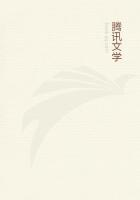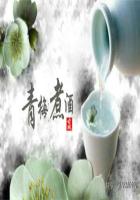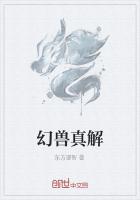In the shorter days after the autumn equinox there may be a rainbow at any time of the day, but in the longer days from the spring to the autumn equinox there cannot be a rainbow about midday. The reason for this is that when the sun is north of the equator the visible arcs of its course are all greater than a semicircle, and go on increasing, while the invisible arc is small, but when the sun is south of the equator the visible arc is small and the invisible arc great, and the farther the sun moves south of the equator the greater is the invisible arc. Consequently, in the days near the summer solstice, the size of the visible arc is such that before the point H reaches the middle of that arc, that is its point of culmination, the point is well below the horizon; the reason for this being the great size of the visible arc, and the consequent distance of the point of culmination from the earth. But in the days near the winter solstice the visible arcs are small, and the contrary is necessarily the case: for the sun is on the meridian before the point H has risen far.
6
Mock suns, and rods too, are due to the causes we have described.
A mock sun is caused by the reflection of sight to the sun. Rods are seen when sight reaches the sun under circumstances like those which we described, when there are clouds near the sun and sight is reflected from some liquid surface to the cloud. Here the clouds themselves are colourless when you look at them directly, but in the water they are full of rods. The only difference is that in this latter case the colour of the cloud seems to reside in the water, but in the case of rods on the cloud itself. Rods appear when the composition of the cloud is uneven, dense in part and in part rare, and more and less watery in different parts. Then the sight is reflected to the sun: the mirrors are too small for the shape of the sun to appear, but, the bright white light of the sun, to which the sight is reflected, being seen on the uneven mirror, its colour appears partly red, partly green or yellow. It makes no difference whether sight passes through or is reflected from a medium of that kind; the colour is the same in both cases; if it is red in the first case it must be the same in the other.
Rods then are occasioned by the unevenness of the mirror-as regards colour, not form. The mock sun, on the contrary, appears when the air is very uniform, and of the same density throughout. This is why it is white: the uniform character of the mirror gives the reflection in it a single colour, while the fact that the sight is reflected in a body and is thrown on the sun all together by the mist, which is dense and watery though not yet quite water, causes the sun's true colour to appear just as it does when the reflection is from the dense, smooth surface of copper. So the sun's colour being white, the mock sun is white too. This, too, is the reason why the mock sun is a surer sign of rain than the rods; it indicates, more than they do, that the air is ripe for the production of water.
Further a mock sun to the south is a surer sign of rain than one to the north, for the air in the south is readier to turn into water than that in the north.
Mock suns and rods are found, as we stated, about sunset and sunrise, not above the sun nor below it, but beside it. They are not found very close to the sun, nor very far from it, for the sun dissolves the cloud if it is near, but if it is far off the reflection cannot take place, since sight weakens when it is reflected from a small mirror to a very distant object. (This is why a halo is never found opposite to the sun.) If the cloud is above the sun and close to it the sun will dissolve it; if it is above the sun but at a distance the sight is too weak for the reflection to take place, and so it will not reach the sun. But at the side of the sun, it is possible for the mirror to be at such an interval that the sun does not dissolve the cloud, and yet sight reaches it undiminished because it moves close to the earth and is not dissipated in the immensity of space. It cannot subsist below the sun because close to the earth the sun's rays would dissolve it, but if it were high up and the sun in the middle of the heavens, sight would be dissipated.
Indeed, even by the side of the sun, it is not found when the sun is in the middle of the sky, for then the line of vision is not close to the earth, and so but little sight reaches the mirror and the reflection from it is altogether feeble.
Some account has now been given of the effects of the secretion above the surface of the earth; we must go on to describe its operations below, when it is shut up in the parts of the earth.
Just as its twofold nature gives rise to various effects in the upper region, so here it causes two varieties of bodies. We maintain that there are two exhalations, one vaporous the other smoky, and there correspond two kinds of bodies that originate in the earth, 'fossiles' and metals. The heat of the dry exhalation is the cause of all 'fossiles'. Such are the kinds of stones that cannot be melted, and realgar, and ochre, and ruddle, and sulphur, and the other things of that kind, most 'fossiles' being either coloured lye or, like cinnabar, a stone compounded of it. The vaporous exhalation is the cause of all metals, those bodies which are either fusible or malleable such as iron, copper, gold. All these originate from the imprisonment of the vaporous exhalation in the earth, and especially in stones. Their dryness compresses it, and it congeals just as dew or hoar-frost does when it has been separated off, though in the present case the metals are generated before that segregation occurs. Hence, they are water in a sense, and in a sense not. Their matter was that which might have become water, but it can no longer do so: nor are they, like savours, due to a qualitative change in actual water. Copper and gold are not formed like that, but in every case the evaporation congealed before water was formed. Hence, they all (except gold) are affected by fire, and they possess an admixture of earth; for they still contain the dry exhalation.
This is the general theory of all these bodies, but we must take up each kind of them and discuss it separately.


